Voisin-style Rational Grazing
Interview with Daniel Suárez (rancher and grazing educator)
This is Part 2 of my interview with rancher and grazing educatior Daniel Suárez about how he manages his own grazing herd using Voisin-style Rational Grazing.
In Part I Daniel introduced us to his cattle ranch in Mexico. He also explained the four universal grazing laws and the concept of the "optimal rest period," as well as how Rational Grazing differs from other rotational grazing strategies.
In this part of the interview, Daniel explains how he set up his pastures (and water system) for Rational Grazing. He also describes his day-to-day pasture management routine and shares his observations of how his pastures (and his farm balance sheet) have improved since switching to this grazing management strategy.
Hands-On Rational Grazing at Rancho El Yaqui
What was your grazing management strategy before switching to Voisin's Rational Grazing?
Prior to switching to Rational Grazing, we used to use very large paddocks (many hectares each), which the cattle occupied for very long time periods (10-20 days each). This caused our animal carrying capacity to be very low and the grazing impact was very selective.
That type of management required constant reapplications of herbicides to eliminate the weeds. And because grazing was so selective, it also required constant mowing to cut down the old woody grass left behind by the grazing cattle. Here in the tropics fire is widely used to clean up the pastures after grazing, with dire consequences for the soil because the fire consumes the little organic matter that has managed to accumulate in the soil.
The carrying capacity that we had before switching to Rational Grazing was around 0.6 cows per hectare (300 kg/ha) during the rainy season. This carrying capacity jumped to around 1.3 cows per hectare when we initially installed the paddocks for Rational Grazing, basically just because of the difference in grazing efficiency caused by installing the fences.
Currently our carrying capacity averaged over the complete year is around 1.8 cows per hectare, which works out to around 900 kg/ha overall (and around 2500 kg/ha in the rainy season). And I expect this carrying capacity to continue to increase. I can only estimate - there is no way to calculate this to be sure - but I expect my carrying capacity to reach around 4 cows per hectare in a few years. To achieve this healthy, low-cost pest-free ecosystem, the soil will need to continue to improve, which is happening thanks to the increase in organic matter in the soil caused by plant residues and animal manure, and because of the increase in soil microbiology that happens now that we have stopped using herbicides.
What changes have you noticed in your pastures since you switched to Rational Grazing?
The biggest change was the big increase in carrying capacity, without using any fertilizers or agro-chemicals.
The second big change was the health of our animals. Our breed is not a tropically-adapted breed (we are currently working on introducing tropical genetics to our herd to improve their heat-tolerance), but nonetheless, since making this change our cattle suffer from far fewer health problems. This is attributed to the pastures being more nutritious - the phrase "you are what you eat" seems very appropriate in this case.
Thanks to the increase in carrying capacity, combined with the reduction in veterinary medications and the reduction in external farm inputs, this has resulted in a much lower production cost and improved profitability for our farm.
The other very important change, which I don't know how to quantify, but it is very noticeable, is the increased diversity of birds and wildlife on the ranch. Nowadays we see lots of different types of raptors every day, and we even have some migratory birds that arrive that were never here before. We've also seen a surge in opossums, skunks, armadillos, rabbits, quail, and even otters in one of the reservoirs.
While these observations are only indirectly related to our cattle herd, all of these animals depend on the soil in some way, so it is a reflection of the improvement in the health and fertility of our farm ecosystem using this grazing strategy. Having more life in the soil (more worms, beetles, etc.) means there is abundant food for mice, skunks, and armadillos, which in turn feed the raptors. Greater biodiversity on the ranch means the farm is healthier and more productive, which makes us more efficient and reduces our production costs. The opposite is desertification - the loss of biodiversity.
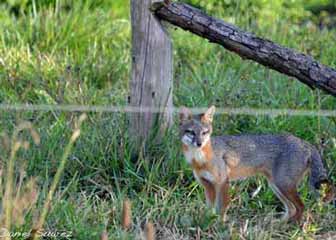 Grey fox patrolling the pasture alleys on Rancho El Yaqui.
Grey fox patrolling the pasture alleys on Rancho El Yaqui.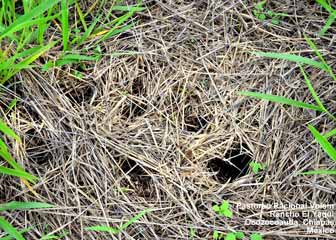 Holes left by armadillos digging for worms and insects in the pasture soils.
Holes left by armadillos digging for worms and insects in the pasture soils.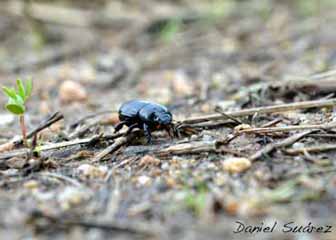 Dung beetle in Rancho El Yaqui's pastures.
Dung beetle in Rancho El Yaqui's pastures.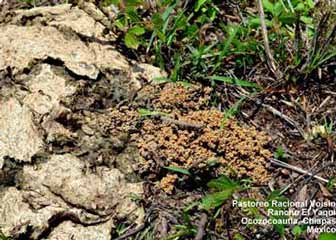 Signs of dung beetles in pasture manure.
Signs of dung beetles in pasture manure.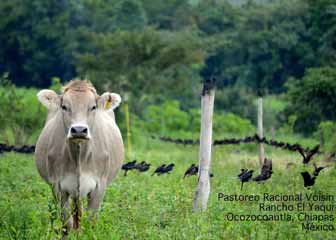 Abundance of birds around the cattle.
Abundance of birds around the cattle.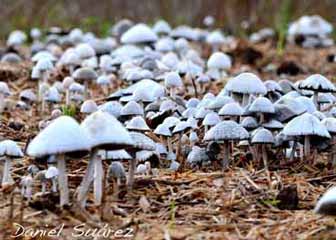 Mushrooms growing where hay was fed to supplement pastures during the dry season. If hay is used, it is always fed on the poorest soils. The leftovers and cattle dung help rejuvenate the soil.
Mushrooms growing where hay was fed to supplement pastures during the dry season. If hay is used, it is always fed on the poorest soils. The leftovers and cattle dung help rejuvenate the soil.How did you set up your fences for Voisin-style Rational Grazing?
To set up the grazing infrastructure on a ranch, it is necessary to understand all the factors involved in the production system. You have to start by analyzing all your needs and objectives, much like when planning the blueprint for building a house, and then you combine these needs with the opportunities provided by the terrain, the materials, the climate, and the economic considerations. You have to come up with a design based on your individual farm, which allows you to efficiently graze your cattle year-round. The layout should also allow you to easily create emergency grazing reserves.
I have 130 paddocks of about 5000 m² each, with alleys between them that are between 5 and 6 meters wide. These 130 paddocks are for adult cattle, so they only have a single galvanized electric wire, approximately 80 cm above the ground.
I still am lacking the additional paddocks for the calves. In this module the paddocks will be even smaller, approximately 700 m², with two wires at a height of 80 and 50 cm.
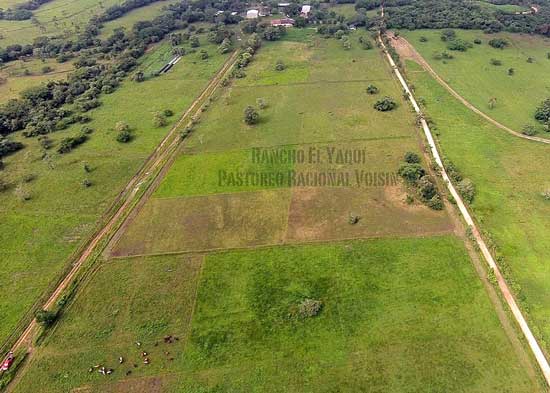 Paddocks and alleys at Rancho El Yaqui.
Paddocks and alleys at Rancho El Yaqui.How do you provide your cattle with water during grazing?
The pasture design includes a network of pressurized water lines to bring water to the cattle. A hydrant is placed every 3rd, 4th, or 5th paddock (depending on topography) and a mobile water trough is connected to the hydrant and placed in whichever paddock the cattle are that day.
In Rational Grazing, the water goes to the cattle, the cattle do not go to the water. Water is the most important nutrient, even more important than the grass, so it should neither be limited, nor complicated to access. Milk and beef are approximately 88% and 70% water, so we should not skimp on the supply of livestock water.
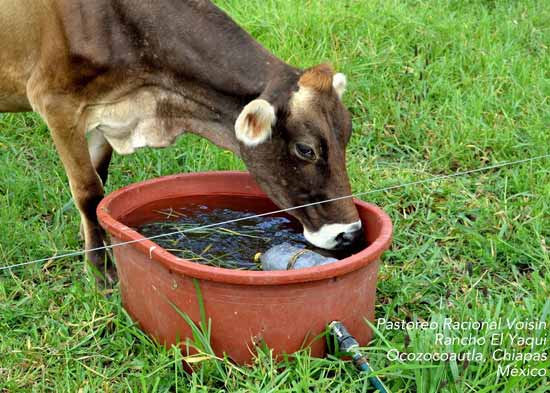 Low cost mobile water tub that follows the cattle during grazing.
Low cost mobile water tub that follows the cattle during grazing.With permanent pasture divisions, your pasture slices always stay the same size, but you change the TIME in each pasture slice. What is the advantage of using this strategy instead of using temporary pasture divisions to change the SIZE instead so that time in each grazing slice stays the same each day?
With permanent pasture divisions you theoretically have variable time periods in each paddock. However, we use portable electric fences a lot to further subdivide the paddocks to achieve a better pasture utilization.
For example, if I calculate that a paddock has sufficient grass for two days, then I will divide that paddock into two parts so that each half provides one day of grazing. And if I want to increase the grazing impact even more for some reason, such as to eliminate weeds or loosen hard compacted soils, then I will use temporary portable electric fences to subdivide the paddock into as much as 8 or more grazing slices with much more frequent pasture moves. This creates what is called “Ultra High-Density Grazing.”
So in theory, having a system of permanent paddock divisions creates a rigid grazing system, but in reality it is the opposite. You obtain a system that you can manage according to your needs and whims, with the least amount of effort. With this system you have to invest a little more to set up the infrastructure, but the investment pays off handsomely in the long-term.
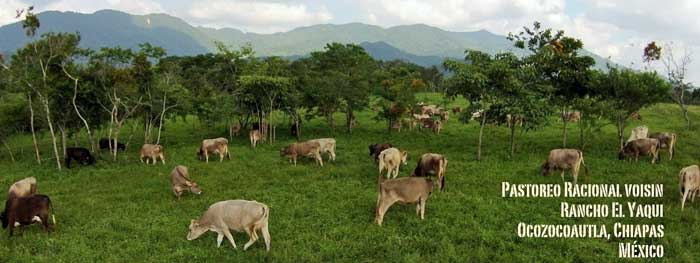 5000 m² paddock divided into 4 parts with portable electric fencing, achieving a grazing density of 400 animal units per hectare.
5000 m² paddock divided into 4 parts with portable electric fencing, achieving a grazing density of 400 animal units per hectare.How did you calculate the size of your permanent paddocks when you first set up your fences?
It is a process of calculation and analysis of resources (nutritional, water, genetic, economic, marketing, and human) to develop the project and design it. It is not a simple calculation and a lot of the factors that are involved have to be estimated and may change in the future. However, the key is to determine the length of the critical season (dry season when the grass grows at its slowest rate or stops growing altogether) so you can estimate the amount of reserves required so the cattle never run out of forage. In simple terms, this is the formula that is used:
Supposing that during the critical season your grass need 120 days of rest so that the grass can reach its Optimal Rest Period prior to re-grazing. And supposing that I plan to spend 2 days in each paddock and I have two separate groups of cattle grazing in a leader-follower grazing style (the first group top-grazes and the second group cleans up after the first). So in this system, I would need 62 permanent paddocks.
Now suppose that I have 50 hectares available for the batch of cattle that I am doing this calculation for (which could be brood cows, weanlings, replacement heifers, etc.), then I would use the following formula:
I would eliminate approximately 10% of the total area because that will set aside to build the alleyways. Because alleys don’t produce any forage, it is quite normal that the farmer does not want to leave any room for alleys or that he would like to build as few alleys as possible. However, in Rational Grazing, the alleys do also grow forage and they are also grazeable, so this area is not lost.
So, in this example, after removing 10% of the area for alleys, we have 45 hectares remaining from our original 50 hectares, which works out to 450,000 m², divided by 62 paddocks, which creates paddocks sized at 7,258 m². Let’s round that off to 7,250 m² each.
Broadly speaking, that is how we arrive at the size of each paddock, but to arrive at these numbers it is necessary to make a series of analyses about the production goals and the resources required within the grazing area.
How do you calculate if your stocking rate is correct, too high, or too low to match the grass growth each year?
This is a bit complicated, but possible, and anyone can do it. Normally, during the rainy season you should consume about 25-30% of the total area, leaving 70-75% of the grass to rest for use later in the critical season (dry season or winter). Or, if the weather and the soil permits, you can make silage or hay with this extra grass.
The calculation is easy and is done in the same way in all grazing systems. If you know the requirements of the cattle (how many kilograms of forage they consume each day and how many animals there are), and you can estimate the length of the critical season, with these numbers you can estimate the minimum amount of forage you will need to feed your cattle for the entire year, and in particular, how much forage you will need during the time of year when grass is scarce.
The next step is to do a forage inventory, taking representative samples and multiplying the kilograms obtained by the total available area. With this data, it is possible to know if you have excess grass or a shortage.
It is recommended to always remain somewhat below your maximum stocking capacity because it is easier to deal with an excess than a shortage of pasture. It is also important to remember that we are working with natural forces that we can neither predict nor control, so it is better to be prepared with excess forage reserves in case of extreme weather. If you don't use your emergency forage reserves, you can always sell them at the start of the next growing season.
How often do you move your cattle to fresh pasture? How do you
calculate the length of time your animals will spend in each pasture
slice?
We move our beef cattle at least once per day. The dairy cattle get moved twice per day (after each milking).
You don’t calculate the amount of time, you estimate it, since there are lots of different factors to determine each day’s forage consumption.
To begin with you have to calculate the stocking capacity of each of the paddocks (by taking representative samples and weighing them) to be able to know how many days' worth of grazing is contained within each paddock. This first step allows you to calculate how many paddock subdivisions you need so you can move the cattle at the time intervals that you want to use (daily, twice, three times, or more per day).
But as you gain experience over time, you will “refine your eye” so it becomes less and less important to take forage samples to be able to know how much forage you have and how much time the cattle will be able to remain in each paddock.
What is the advantage of moving your cattle multiple times in one day
instead of providing enough pasture for a full day of grazing?
There are a lot of benefits, however, above all it is the efficiency of the grass harvest, which increases with more frequent pasture moves. Better pasture utilization (more even grazing) leads to increases stocking capacity and a higher profit per hectare. With this grazing strategy it is possible to utilize 80% to 85% of all the grass that is produced.
The dairy herd needs to be moved more times each day because they are working as milk producing animals, so their nutritional requirements are very high. Thus, it is necessary to offer them “fresh” pasture several times each day. The dry cows, heifers, steers and brood cows don't need to be moved as often, though they should be moved at least once per day.
The quality of the cow’s grass harvest will go down the more time the cows spend in each paddock. Imagine that you divide a grass plant into three parts - the tip, the middle, and the base. The cattle first eat the tips which are high in protein and somewhat low in fiber. Then they will eat the middle with a better protein-to-fiber balance. And then finally, they will eat the base, with the highest fiber content and the lowest protein content.
Thus, if the paddock is occupied for three days, on the first day the cattle can get diarrhea because of the lush protein-rich grass. On the second day they will have the best balance between protein and fiber. And on the third day, the nutritional quality of the grass will be worse.
We know that the rumen works best if the quality and the type of grass that the cattle eat is consistent from day to day. The microorganisms inside the cows’ digestive system will change depending on the quality of the grass that is eaten each day. A consistent diet from one day to the next keeps these microorganism populations stable and functioning at maximum efficiency.
When cattle are grazed in a small paddock slice with a high stocking capacity (greater than 200 cows per hectare), each cow will harvest the entire plant, from tip to base, in a very short period of time. This causes the forage that enters the rumen to be a consistent quality, without highs and lows in quality, so that this formidable fermentation chamber (the rumen) is able to work at its greatest efficiency.
This is very easy to see in dairy herds when they spend more than a day in the same paddock. When the cows enter the new paddock, milk production initially increases considerably, but then goes down day after day until milk production gets so low that we are forced to move the cows to a fresh pasture. This drop in milk production is so substantial that the cows have to be moved to fresh pasture long before the entire pasture grass has been eaten, which means that the paddocks only get partially utilized and reduces our harvest efficiency.
Moving the cows to a fresh slice of pasture at least once per day means that we get much more thorough harvest efficiency and much higher and more consistent milk production. The same is true of weight gains in the beef herd. Even though we can’t see changes in daily weight gains as easily as we can measure changes in milk volume and milk fat in a dairy milking parlour, the concept is the same.
How short do you graze each pasture slice before moving on to the next slice? Is it the same in the rainy season and in the dry season?
During the rainy season we graze right down to the base using the “law of the fist” - the grass should not remain higher than fist height (no more than 10 cm). This is only possible when grass is grazed at its “Optimal Rest Period”, because the grass will be nutritious right down to its base, and soft, so the cattle can tear it off easily while grazing. Some people leave a taller stubble, 20 to 25 cm.
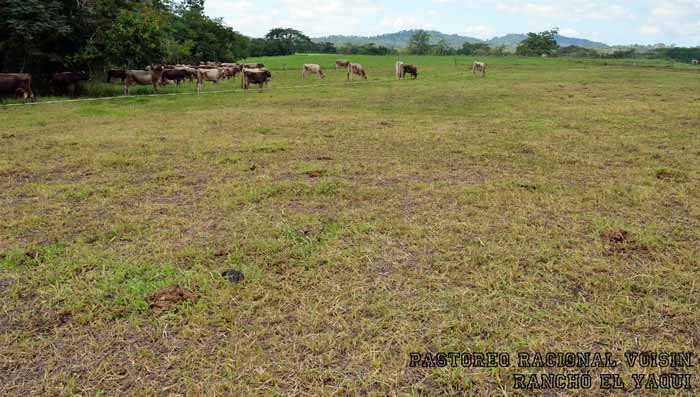 During the rainy season, grass is grazed right down to the base.
During the rainy season, grass is grazed right down to the base.Leaves are more nutritious for cattle than stems, so because our pastures produce large volumes of high quality grass leaves, it is always necessary to remove as much as possible to avoid leaving a stubble.
When the plant is defoliated through grazing, it uses starches stored in the roots to produce fresh leaves. These first fresh leaves cause the photosynthesis process to restart, which then drives the rest of the plant to grow and develop. The stubble left behind after grazing is plant tissue that is not able to produce photosynthesis, yet these tissues still breathe and require resources to sustain them. The only resources available to the plant immediately after grazing are those stored within the roots. So a tall remaining stubble divides the energy available from the roots - some of that energy can be used to produce fresh leaves, but some is also simply required to maintain the stubble and keep the stubble alive.
Thus, the more stubble that is left, the less new leaves can be produced by our plant. So a tall stubble compromises the amount of re-growth that can be produced after grazing. Consequently, during the peak growing season (in my case this is the rainy season), it is best to graze as short as possible.
Grazing changes during the dry season. Since there is very little re-growth (or sometimes none at all) during this time of year, if we graze right down to the soil the sun would shine directly down onto the plant base, which would increase stress on the plant and kill a large percentage of the paddock.
So in the dry season we try to leave a taller grass stubble, 20 to 25 cm, so that this stubble can provide a bit of shade. This little bit of shade reduces stress on the plant base and keeps it a little cooler.
There are paddocks that are not grazed at all during the rainy season. These are left as grazing reserves. When we graze these paddocks, we do graze these right down to the base of the plant. However, with the high amount of stalks and forage contained in these paddocks, a lot of this material will be trampled and left on the soil without being eaten. So this trampled material serves as the protective ground cover to shade and protect the plant base. You can see this in the photo below:
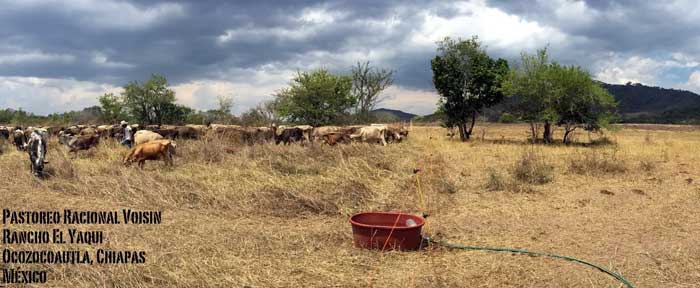 During the dry season, grass is grazed right down while maintaining a good soil cover.
During the dry season, grass is grazed right down while maintaining a good soil cover.More Grazing Management Tips:
Continued on the next page...



